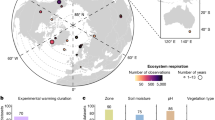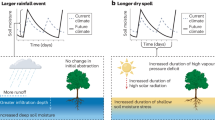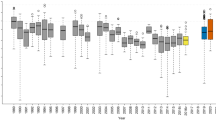Abstract
Accurate climate projections require an understanding of the effects of warming on ecological communities and the underlying mechanisms that drive them1,2,3. However, little is known about the effects of climate warming on the succession of microbial communities4,5. Here we examined the temporal succession of soil microbes in a long-term climate change experiment at a tall-grass prairie ecosystem. Experimental warming was found to significantly alter the community structure of bacteria and fungi. By determining the time-decay relationships and the paired differences of microbial communities under warming and ambient conditions, experimental warming was shown to lead to increasingly divergent succession of the soil microbial communities, with possibly higher impacts on fungi than bacteria. Variation partition- and null model-based analyses indicate that stochastic processes played larger roles than deterministic ones in explaining microbial community taxonomic and phylogenetic compositions. However, in warmed soils, the relative importance of stochastic processes decreased over time, indicating a potential deterministic environmental filtering elicited by warming. Although successional trajectories of microbial communities are difficult to predict under future climate change scenarios, their composition and structure are projected to be less variable due to warming-driven selection.
This is a preview of subscription content, access via your institution
Access options
Access Nature and 54 other Nature Portfolio journals
Get Nature+, our best-value online-access subscription
$29.99 / 30 days
cancel any time
Subscribe to this journal
Receive 12 print issues and online access
$209.00 per year
only $17.42 per issue
Buy this article
- Purchase on Springer Link
- Instant access to full article PDF
Prices may be subject to local taxes which are calculated during checkout




Similar content being viewed by others
References
IPCC Climate Change 2013: The Physical Science Basis (eds Stocker, T. F. et al.) (Cambridge Univ. Press, 2013).
Zhou, J. et al. Microbial mediation of carbon-cycle feedbacks to climate warming. Nat. Clim. Change 2, 106–110 (2012).
Heimann, M. & Reichstein, M. Terrestrial ecosystem carbon dynamics and climate feedbacks. Nature 451, 289–292 (2008).
Van Der Gast, C. J., Ager, D. & Lilley, A. K. Temporal scaling of bacterial taxa is influenced by both stochastic and deterministic ecological factors. Environ. Microbiol. 10, 1411–1418 (2008).
Adler, P. B. & Lauenroth, W. K. The power of time: spatiotemporal scaling of species diversity. Ecol. Lett. 6, 749–756 (2003).
Brown, J. H., Gillooly, J. F., Allen, A. P., Savage, V. M. & West, G. B. Toward a metabolic theory of ecology. Ecology 85, 1771–1789 (2004).
Chen, I. C., Hill, J. K., Ohlemuller, R., Roy, D. B. & Thomas, C. D. Rapid range shifts of species associated with high levels of climate warming. Science 333, 1024–1026 (2011).
Sherry, R. A. et al. Divergence of reproductive phenology under climate warming. Proc. Natl Acad. Sci. USA 104, 198–202 (2007).
Berg, M. P. et al. Adapt or disperse: understanding species persistence in a changing world. Glob. Change Biol. 16, 587–598 (2010).
Xue, K. et al. Tundra soil carbon is vulnerable to rapid microbial decomposition under climate warming. Nat. Clim. Change 6, 595–600 (2016).
Cardinale, B. J. et al. Biodiversity loss and its impact on humanity. Nature 486, 59–67 (2012).
Bebber, D. P., Ramotowski, M. A. & Gurr, S. J. Crop pests and pathogens move polewards in a warming world. Nat. Clim. Change 3, 985–988 (2013).
Sistla, S. A. et al. Long-term warming restructures Arctic tundra without changing net soil carbon storage. Nature 497, 615–618 (2013).
Prach, K. & Walker, L. R. Four opportunities for studies of ecological succession. Trends Ecol. Evol. 26, 119–123 (2011).
Walker, L. R. & Del Moral, R. Primary Succession and Ecosystem Rehabilitation (Cambridge Univ. Press, Cambridge, 2003).
Li, S. P. et al. Convergence and divergence in a long‐term old‐field succession: the importance of spatial scale and species abundance. Ecol. Lett. 19, 1101–1109 (2016).
Fukami, T., Martijn Bezemer, T., Mortimer, S. R. & Putten, W. H. Species divergence and trait convergence in experimental plant community assembly. Ecol. Lett. 8, 1283–1290 (2005).
Inouye, R. S. & Tilman, D. Convergence and divergence of old‐field vegetation after 11 yr of nitrogen addition. Ecology 76, 1872–1887 (1995).
Zhou, J. et al. Stochasticity, succession, and environmental perturbations in a fluidic ecosystem. Proc. Natl Acad. Sci. USA 111, E836–E845 (2014).
Schleicher, A., Peppler-Lisbach, C. & Kleyer, M. Functional traits during succession: is plant community assembly trait-driven? Preslia 83, 347–370 (2011).
Maignien, L., DeForce, E. A., Chafee, M. E., Eren, A. M. & Simmons, S. L. Ecological succession and stochastic variation in the assembly of Arabidopsis thaliana phyllosphere communities. MBio 5, e00682-13 (2014).
Veach, A. M., Stegen, J. C., Brown, S. P., Dodds, W. K. & Jumpponen, A. Spatial and successional dynamics of microbial biofilm communities in a grassland stream ecosystem. Mol. Ecol. 25, 4674–4688 (2016).
Nemergut, D. R. et al. Decreases in average bacterial community rRNA operon copy number during succession. ISME J. 10, 1147–1156 (2016).
Xu, X., Sherry, R. A., Niu, S., Li, D. & Luo, Y. Net primary productivity and rain-use efficiency as affected by warming, altered precipitation, and clipping in a mixed-grass prairie. Glob. Change Biol. 19, 2753–2764 (2013).
Li, D., Zhou, X., Wu, L., Zhou, J. & Luo, Y. Contrasting responses of heterotrophic and autotrophic respiration to experimental warming in a winter annual-dominated prairie. Glob. Change Biol. 19, 3553–3564 (2013).
Nakagawa, S. & Schielzeth, H. A general and simple method for obtaining R2 from generalized linear mixed-effects models. Methods Ecol. Evol. 4, 133–142 (2013).
Chen, L.-x et al. Comparative metagenomic and metatranscriptomic analyses of microbial communities in acid mine drainage. ISME J. 9, 1579–1592 (2015).
Webb, C. O., Ackerly, D. D., McPeek, M. A. & Donoghue, M. J. Phylogenies and community ecology. Annu. Rev. Ecol. Syst. 33, 475–505 (2002).
Zhou, J. & Ning, D. Stochastic community assembly: does it matter in microbial ecology? Microbiol. Mol. Biol. Rev. 81, e00002-17 (2017).
Zhou, J. et al. Temperature mediates continental-scale diversity of microbes in forest soils. Nat. Commun. 7, 12083 (2016).
Niu, S. et al. Water-mediated responses of ecosystem carbon fluxes to climatic change in a temperate steppe. New Phytol. 177, 209–219 (2008).
Frank, D. A. & McNaughton, S. J. Aboveground biomass estimation with the canopy intercept method: a plant growth form caveat. Oikos 57, 57–60 (1990).
Sherry, R. A. et al. Lagged effects of experimental warming and doubled precipitation on annual and seasonal aboveground biomass production in a tallgrass prairie. Glob. Change Biol. 14, 2923–2936 (2008).
McLean, E. O. in Methods of Soil Analysis. Part 2: Chemical and Microbiological Properties (ed. Page, A. L.) 199–224 (Soil Science Society of America, Madison, WI, 1982).
Zhou, J., Bruns, M. A. & Tiedje, J. M. DNA recovery from soils of diverse composition. Appl. Environ. Microbiol. 62, 316–322 (1996).
Wu, L. et al. Phasing amplicon sequencing on Illumina Miseq for robust environmental microbial community analysis. BMC Microbiol. 15, 125 (2015).
Peiffer, J. A. et al. Diversity and heritability of the maize rhizosphere microbiome under field conditions. Proc. Natl Acad. Sci. USA 110, 6548–6553 (2013).
Caporaso, J. G. et al. Ultra-high-throughput microbial community analysis on the Illumina HiSeq and MiSeq platforms. ISME J. 6, 1621–1624 (2012).
Giardine, B. et al. Galaxy: a platform for interactive large-scale genome analysis. Genome Res. 15, 1451–1455 (2005).
Kong, Y. Btrim: a fast, lightweight adapter and quality trimming program for next-generation sequencing technologies. Genomics 98, 152–153 (2011).
Magoč, T. & Salzberg, S. L. FLASH: fast length adjustment of short reads to improve genome assemblies. Bioinformatics 27, 2957–2963 (2011).
Edgar, R. C. UPARSE: highly accurate OTU sequences from microbial amplicon reads. Nat. Methods 10, 996–998 (2013).
DeSantis, T. Z. et al. Greengenes, a chimera-checked 16S rRNA gene database and workbench compatible with ARB. Appl. Environ. Microbiol. 72, 5069–5072 (2006).
Wang, Q., Garrity, G. M., Tiedje, J. M. & Cole, J. R. Naive Bayesian classifier for rapid assignment of rRNA sequences into the new bacterial taxonomy. Appl. Environ. Microbiol. 73, 5261–5267 (2007).
Dixon, P. VEGAN. a package of R functions for community ecology. J. Veg. Sci. 14, 927–930 (2009).
McMurdie, P. J. & Holmes, S. phyloseq: an R package for reproducible interactive analysis and graphics of microbiome census data. PloS ONE 8, e61217 (2013).
Shade, A., Gregory Caporaso, J., Handelsman, J., Knight, R. & Fierer, N. A meta-analysis of changes in bacterial and archaeal communities with time. ISME J. 7, 1493–1506 (2013).
Liang, Y. et al. Long-term soil transplant simulating climate change with latitude significantly alters microbial temporal turnover. ISME J. 9, 2561–2572 (2015).
Nekola, J. C. & White, P. S. The distance decay of similarity in biogeography and ecology. J. Biogeogr. 26, 867–878 (1999).
Deng, Y. et al. Elevated carbon dioxide accelerates the spatial turnover of soil microbial communities. Glob. Change Biol. 22, 957–964 (2016).
Martiny, J. B., Eisen, J. A., Penn, K., Allison, S. D. & Horner-Devine, M. C. Drivers of bacterial β-diversity depend on spatial scale. Proc. Natl Acad. Sci. USA 108, 7850–7854 (2011).
Benjamini, Y. & Hochberg, Y. Controlling the false discovery rate: a practical and powerful approach to multiple testing. J. R. Stat. Soc. B, 289–300 (1995).
R Development Core Team R: A Language and Environment for Statistical Computing (R Foundation for Statistical Computing, 2011).
Chase, J. M. & Myers, J. A. Disentangling the importance of ecological niches from stochastic processes across scales. Phil. Trans. R. Soc. B 366, 2351–2363 (2011).
Stegen, J. C., Lin, X., Konopka, A. E. & Fredrickson, J. K. Stochastic and deterministic assembly processes in subsurface microbial communities. ISME J. 6, 1653–1664 (2012).
Kruskal, J. B. Nonmetric multidimensional scaling: a numerical method. Psychometrika 29, 115–129 (1964).
Acknowledgements
This work is supported by the US Department of Energy, Office of Science, Genomic Science Program under award numbers DE-SC0004601 and DE-SC0010715, the National Science Foundation of China (no. 41430856) and the Office of the Vice President for Research at the University of Oklahoma. X.G. and X.Z. were generously supported by the China Scholarship Council (CSC).
Author information
Authors and Affiliations
Contributions
All authors contributed intellectual input and assistance to this study and manuscript preparation. The original concept and experimental strategy were developed by J.Z., Y.L. and J.M.T. Field management was carried out by J.F., M.Y., Z.S., X.Z., X.G., T.Y., L.W., J.W., A.Z. and J.D.V.N. Sampling collections, DNA preparation and MiSeq sequencing analysis were carried out by X.G., J.F., X.Z., M.Y., X.T., Y.F. and L.H. Soil chemical analysis was carried out by X.Z. Various statistical analyses were carried by X.G., Z.S., D.N., Y.Q. and M.Y. Assistance in data interpretation was provided by X.L., Y.Y. and Z.H. All data analysis and integration were guided by J.Z. The paper was written by J.Z. and X.G. with help from Z.H., Y.Y., L.H. and J.M.T.
Corresponding authors
Ethics declarations
Competing interests
The authors declare no competing interests.
Additional information
Publisher’s note: Springer Nature remains neutral with regard to jurisdictional claims in published maps and institutional affiliations.
Supplementary Information
Supplementary Information
Supplementary figures 1–11, Supplementary tables 1–8
Rights and permissions
About this article
Cite this article
Guo, X., Feng, J., Shi, Z. et al. Climate warming leads to divergent succession of grassland microbial communities. Nature Clim Change 8, 813–818 (2018). https://doi.org/10.1038/s41558-018-0254-2
Received:
Accepted:
Published:
Issue Date:
DOI: https://doi.org/10.1038/s41558-018-0254-2
This article is cited by
-
Unraveling the interplay between root exudates, microbiota, and rhizosheath formation in pearl millet
Microbiome (2024)
-
Microbially mediated mechanisms underlie soil carbon accrual by conservation agriculture under decade-long warming
Nature Communications (2024)
-
Nitrogen deposition mediates more stochastic processes in structuring plant community than soil microbial community in the Eurasian steppe
Science China Life Sciences (2024)
-
Experimental warming accelerates positive soil priming in a temperate grassland ecosystem
Nature Communications (2024)
-
May microbial ecological baseline exist in continental groundwater?
Microbiome (2023)



